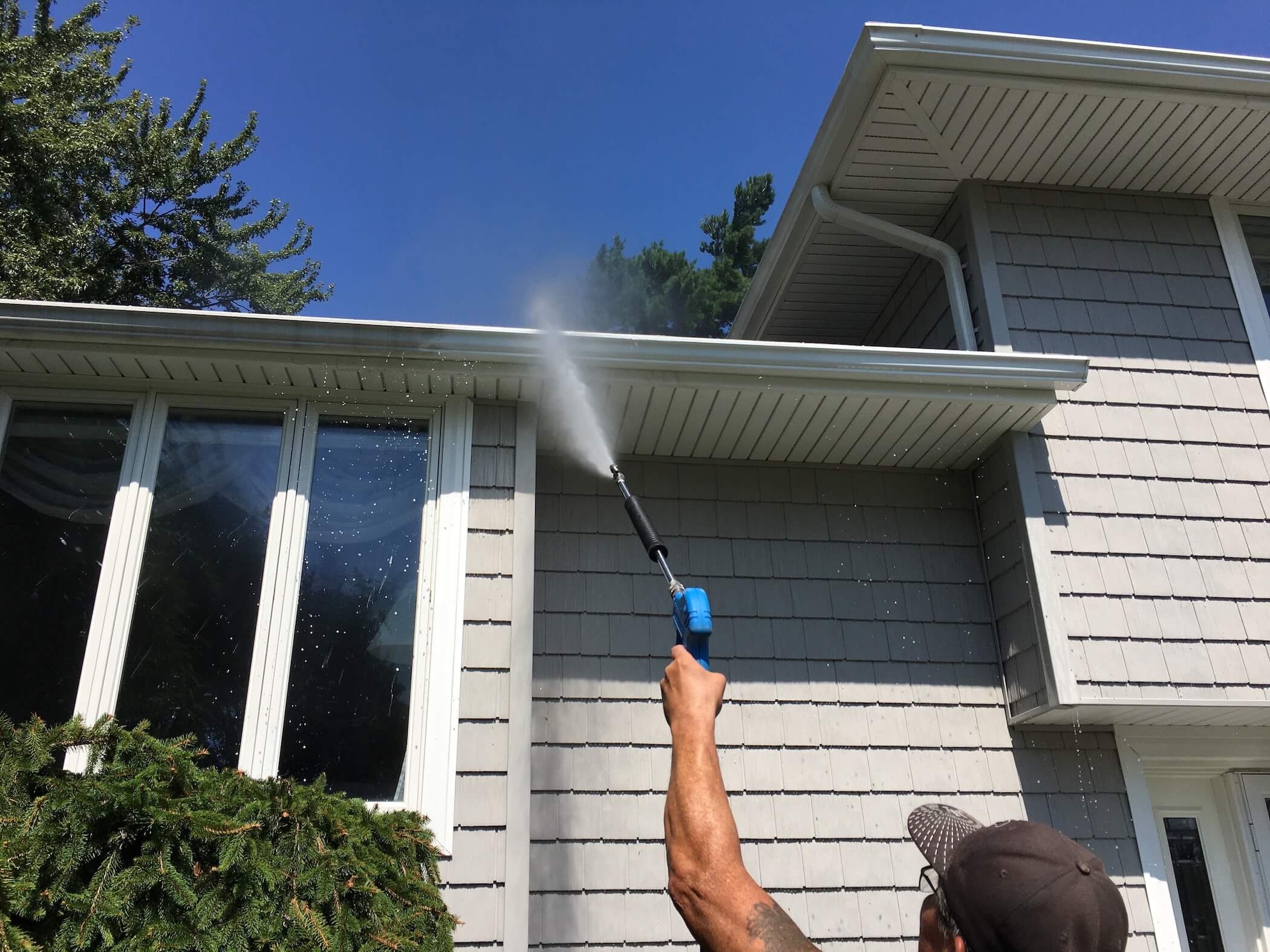
When your home’s exterior starts looking dingy or overrun with algae, you might assume the solution is simple: power wash it. But not so fast! While power washing is a popular cleaning method, there’s another technique that’s equally effective — and sometimes safer — called soft washing.
Both approaches have their place, but using the wrong one can cause more harm than good. So, how do you know which method is right for your job? 💭
Let’s break it all down in plain English — no pressure, just clarity. 💦🧼
🧽 What Is Power Washing?
Power washing (also called pressure washing) uses high-pressure water, sometimes heated, to remove dirt, grime, mold, mildew, and other surface buildup. It’s ideal for hard surfaces that can withstand force.
🔧 Key Features:
- PSI (pressure per square inch): Typically between 2,000–4,000+
- Water Temperature: Often hot (though not always)
- Tools Used: Gas or electric pressure washer with adjustable nozzles
- Effectiveness: Blasts off grime using force
✅ Best For:
- Concrete driveways and sidewalks
- Brick walls and pavers
- Garage floors
- Stone patios
- Metal surfaces
💪 If it’s tough, solid, and durable — power washing can handle it.
Browse Amazon Here For Top Rated Power Washers And Accessories
🌊 What Is Soft Washing?
Soft washing is a low-pressure cleaning method that relies on special cleaning solutions (usually biodegradable detergents) to loosen dirt and kill organic growth like algae, mildew, and bacteria. The water pressure used is very gentle — more like a garden hose with a little extra oomph.
🧴 Key Features:
- PSI: Usually under 500
- Cleaning Agents: Biodegradable soaps and algaecides
- Technique: Spray, soak, rinse
- Effectiveness: Kills growth at the root, doesn’t just remove surface stains
✅ Best For:
- Roof shingles
- Vinyl siding
- Stucco
- Wood fences
- Screens, outdoor furniture, and windows
🌱 Soft washing is all about chemistry, not brute force.
Browse Amazon Here For Soft Washing Equipment And Accessories
🤔 Which Method Should You Use?
Here’s a quick comparison to help you decide:
| Surface | Power Wash | Soft Wash |
|---|---|---|
| Driveway | ✅ | ❌ |
| Roof | ❌ | ✅ |
| Siding (vinyl, painted) | ❌ (can damage) | ✅ |
| Brick | ✅ | ✅ (for mildew) |
| Fence (wood) | ⚠️ (use caution) | ✅ |
| Patio furniture | ❌ | ✅ |
| Stucco | ❌ | ✅ |
| Windows | ❌ | ✅ |
🧠 Pro Tip: If you’re unsure, lean toward soft washing — it’s safer and less likely to cause damage.
⚠️ Risks of Using the Wrong Method
Using high pressure on delicate surfaces can lead to serious problems:
- Cracked vinyl siding
- Stripped paint
- Water intrusion behind walls
- Shingle damage on roofs
- Etching or splintering on wood
On the flip side, soft washing isn’t powerful enough to remove heavy grime or stains from concrete and brick.
💥 The bottom line: match the method to the material.
🏡 Soft Washing for Roofs: A Must-Know
Roofs are one of the most common places homeowners go wrong. Power washing a roof — especially one with asphalt shingles — is a huge no-no. 🚫
High pressure can:
- Dislodge shingles
- Remove protective granules
- Void warranties
- Cause leaks or water damage
Instead, soft washing uses algaecides to kill growth like Gloeocapsa magma (those black streaks you see on shingles), and it won’t damage your roof in the process. 🌤️
🧰 What Equipment Do You Need?
Power Washing:
- Pressure washer (gas or electric)
- Nozzles (0°, 15°, 25°, 40°)
- Surface cleaner attachment (for driveways)
- Safety gear (gloves, goggles, boots)
Soft Washing:
- Pump sprayer or low-pressure washer
- Biodegradable cleaning solution
- Hose with rinse nozzle
- Optional: ladder, brushes, buckets
🛠️ If you’re a homeowner doing it yourself, soft washing is often more approachable and less risky.
Browse Amazon Here For Top Rated Power Washers And Accessories
💸 Cost Comparison: Power Washing vs. Soft Washing
If you’re hiring a pro, here’s what you can expect to pay:
| Service | Power Wash | Soft Wash |
|---|---|---|
| House Exterior | $250–$500 | $300–$600 |
| Roof | Not recommended | $400–$800 |
| Driveway | $100–$300 | Not effective |
| Deck | $150–$400 | $200–$450 |
📈 Soft washing often costs more because it requires special cleaning agents and takes more time — but it lasts longer and is gentler.
♻️ Eco-Friendliness
Many soft wash solutions are biodegradable and environmentally safe, especially compared to the heavy chemical cleaners sometimes used in power washing. 🌿
Still, always:
- Check for EPA Safer Choice certified products
- Avoid bleach near plants or waterways
- Collect runoff when possible
- Rinse thoroughly to protect landscaping
♻️ Eco-friendly doesn’t mean less effective — it means smarter cleaning.
✅ Final Thoughts
Both power washing and soft washing can make your home shine — but choosing the right method makes all the difference. 🏠✨
If you’re blasting grime from concrete or stone, go with power washing. But if you’re treating siding, wood, or anything that could be damaged by force, stick with soft washing.
The goal is the same either way: a cleaner, safer, more beautiful home — without the risk of damage or regrets. So know your surface, choose your tools wisely, and enjoy that freshly cleaned feeling.
Your home (and your neighbors) will thank you! 🧼🌞💪
Browse Amazon Here For Top Rated Power Washers And Accessories



